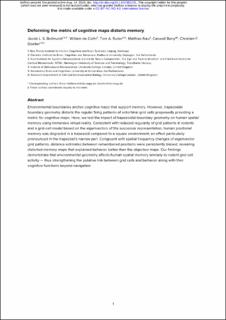| dc.contributor.author | Bellmund, Jacob Lukas Sarid | |
| dc.contributor.author | de Cothi, William | |
| dc.contributor.author | Ruiter, Tom | |
| dc.contributor.author | Nau, Matthias | |
| dc.contributor.author | Barry, Caswell | |
| dc.contributor.author | Doeller, Christian Fritz Andreas | |
| dc.date.accessioned | 2021-09-01T11:42:18Z | |
| dc.date.available | 2021-09-01T11:42:18Z | |
| dc.date.created | 2019-12-10T13:21:06Z | |
| dc.date.issued | 2019 | |
| dc.identifier.issn | 2397-3374 | |
| dc.identifier.uri | https://hdl.handle.net/11250/2772230 | |
| dc.description.abstract | Environmental boundaries anchor cognitive maps that support memory. However, trapezoidal boundary geometry distorts the regular firing patterns of entorhinal grid cells, proposedly providing a metric for cognitive maps. Here we test the impact of trapezoidal boundary geometry on human spatial memory using immersive virtual reality. Consistent with reduced regularity of grid patterns in rodents and a grid-cell model based on the eigenvectors of the successor representation, human positional memory was degraded in a trapezoid environment compared with a square environment—an effect that was particularly pronounced in the narrow part of the trapezoid. Congruent with changes in the spatial frequency of eigenvector grid patterns, distance estimates between remembered positions were persistently biased, revealing distorted memory maps that explained behaviour better than the objective maps. Our findings demonstrate that environmental geometry affects human spatial memory in a similar manner to rodent grid-cell activity and, therefore, strengthen the putative link between grid cells and behaviour along with their cognitive functions beyond navigation. | en_US |
| dc.language.iso | eng | en_US |
| dc.publisher | Nature Research | en_US |
| dc.title | Deforming the metric of cognitive maps distorts memory | en_US |
| dc.type | Journal article | en_US |
| dc.description.version | submittedVersion | en_US |
| dc.source.journal | Nature Human Behaviour | en_US |
| dc.identifier.doi | 10.1038/s41562-019-0767-3 | |
| dc.identifier.cristin | 1758855 | |
| dc.relation.project | EU/724836 | en_US |
| dc.relation.project | Norges forskningsråd: 223262 | en_US |
| dc.relation.project | The Egil and Pauline Braathen and Fred Kavli Centre for Cortical Microcircuits: 00 | en_US |
| dc.relation.project | Kavli Foundation: 00 | en_US |
| cristin.ispublished | true | |
| cristin.fulltext | preprint | |
| cristin.qualitycode | 1 | |
